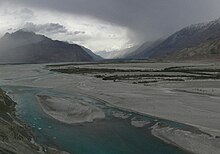| Shyok River | |
|---|---|
 Shyok river Shyok river | |
 Course of the Shyok Course of the Shyok | |
| Etymology | "the river of death" |
| Location | |
| Country | India, Pakistan |
| Territory | Ladakh (India), Gilgit-Baltistan (Pakistan) |
| District | Leh (India), Ghanche (Pakistan) |
| Physical characteristics | |
| Source | |
| • coordinates | 35°21′N 77°37′E / 35.35°N 77.62°E / 35.35; 77.62 |
| Mouth | Indus River |
| • coordinates | 35°14′N 75°55′E / 35.23°N 75.92°E / 35.23; 75.92 |
| Basin size | 33,347 km (12,875 sq mi) |
| Discharge | |
| • location | Yugo gauging station, Pakistan. |
| • average | 1041 m/sec |
| • minimum | 859 m/sec |
| • maximum | 1199 m/sec |
| Basin features | |
| River system | Indus River |
| Tributaries | |
| • left | Chip Chap River, Galwan River, Chang Chenmo River |
| • right | Nubra River, Hushe River |


The Shyok River is a tributary of the Indus River that flows through northern Ladakh and enters Gilgit–Baltistan, in Pakistan, spanning some 550 km (340 mi).
The Shyok River originates at the Rimo Glacier. Its alignment is very unusual. Originating from the Rimo glacier, it flows in a southeasterly direction and, joining the Pangong Range, it takes a northwestern turn, flowing parallel to its previous path. Shyok Valley widens at the confluence with the Nubra River but suddenly turns into a narrow gorge near Yagulung (34°46′N 77°08′E / 34.77°N 77.14°E / 34.77; 77.14), continuing through Bogdang, Turtuk and Tyakshi before crossing into Baltistan. The valley again widens near its Saltoro River junction at Ghursay. The river joins the Indus at Keris, east of the town of Skardu.
The Nubra River, originating from the Siachen glacier, also behaves like the Shyok. Before Diskit, the southeasterly flowing Nubra takes a northwest turn on meeting the river Shyok. The similarity in the courses of these two important rivers probably indicates a series of paleolithic fault lines trending northwest-southeast in delimiting the upper courses of the rivers.
Name
The name Shyok (or Shayog) is derived from Tibetan ཤག་མ (shag) 'gravel' + གཡོག་ (gyog) 'to spread' and therefore means 'gravel spreader', referring to the large quantities of gravel that the river deposits when it floods. The name is sometimes incorrectly glossed as 'river of death'.
Valley
The Shyok Valley is the valley of the Shyok River. It is near the Nubra Valley. Khardung La on the Ladakh Range lies north of Leh and is the gateway to the Shyok and Nubra valleys. The Siachen Glacier lies partway up the latter valley.
Tributaries
The Chang Chen Mo River is formed in the vicinity of Pamzal in Changchinmo plains of Ladakh and flows westward. It ends when it empties into the Shyok River.
The Galwan River is in the southern part of Aksai Chin, Galwan originates in the area of Samzungling and flowing to the west which joins the Shyok River.
The Nubra River is a tributary of the Shyok River, which flows into the Indus River. It flows in the Ladakh region of India.
The Saltoro River begins in the skirts of the Saltoro Kangri peak ridge and flows to the southwest. Another branch starts from the western Siachen glaciers and flows to the west to join it at Dumsum village. North of the Ghursay Valley, it meets Mashburm Peak's Hushe River and empties into Shyok River in southwest.
Tourism
Siachen Base Camp tourist adventure, many monasteries, Pangong Tso etc. are tourism opportunities.
Gallery
-
 Shyok in Khaplu Valley
Shyok in Khaplu Valley
-
 Kharfaq and Yugu
Kharfaq and Yugu
-
 Road marker map
Road marker map
See also
References
- Sharad Singh Negi: Himalayan Rivers, Lakes, and Glaciers. Indus Publishing 1991, ISBN 81-85182-61-2
- H. N. Kaul: Rediscovery of Ladakh. Indus Publishing 1998, ISBN 81-7387-086-1, p. 30-31 (restricted online version (Google Books))
Footnotes
- ^ Harish Kapadia (1999). Across Peaks & Passes in Ladakh, Zanskar & East Karakoram. Indus Publishing. p. 230. ISBN 978-81-7387-100-9.
Shyok: river of death. (Sheo: death).
- "India WRIS Geoviewer". Retrieved 30 September 2024.
- "Detection of Sediment Trends Using Wavelet Transforms in the Upper Indus River". Retrieved 13 May 2024.
- "Turtuk, the village on the India-Pak border, is where the clichés stop and fantasies begin". Archived from the original on 15 May 2015.
- Aerial view of river junction
- Bennett-Jones, Owen; Brown, Lindsay; Mock, John (1 September 2004). Pakistan and the Karakoram Highway. Lonely Planet Regional Guides (6th Revised ed.). Lonely Planet Publications. p. 306. ISBN 978-0-86442-709-0. Retrieved 26 August 2009.
- Peter, F. A. (1977). "Glossary of Place Names in Western Tibet". The Tibet Journal. 2 (2): 5–37. JSTOR 43299854. Retrieved 18 November 2022.
External links
- Shyok River at the Encyclopædia Britannica
- Shyok River
- Shyok River
- "Shyok Valley Project - An Experiment In Suof Jammu and Kashmir"
| Capital: Kargil; Leh | |||||||||||||||||||
| State symbols | |||||||||||||||||||
| History |
| ||||||||||||||||||
| Administration | |||||||||||||||||||
| Geography |
| ||||||||||||||||||
| Human settlements | |||||||||||||||||||
| Culture |
| ||||||||||||||||||
| Tourism and wildlife |
| ||||||||||||||||||
| Transport |
| ||||||||||||||||||
| Infrastructure |
| ||||||||||||||||||
| See also |
| ||||||||||||||||||
| Hydrography of Ladakh | |
|---|---|
| Rivers | |
| Glaciers | |